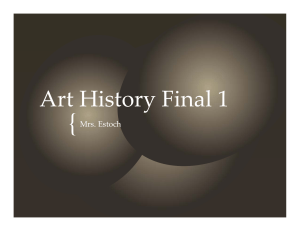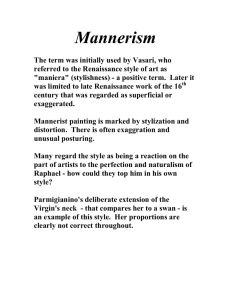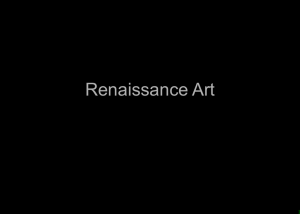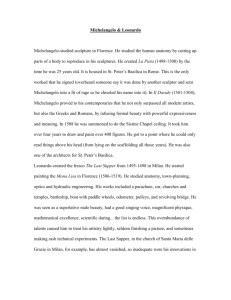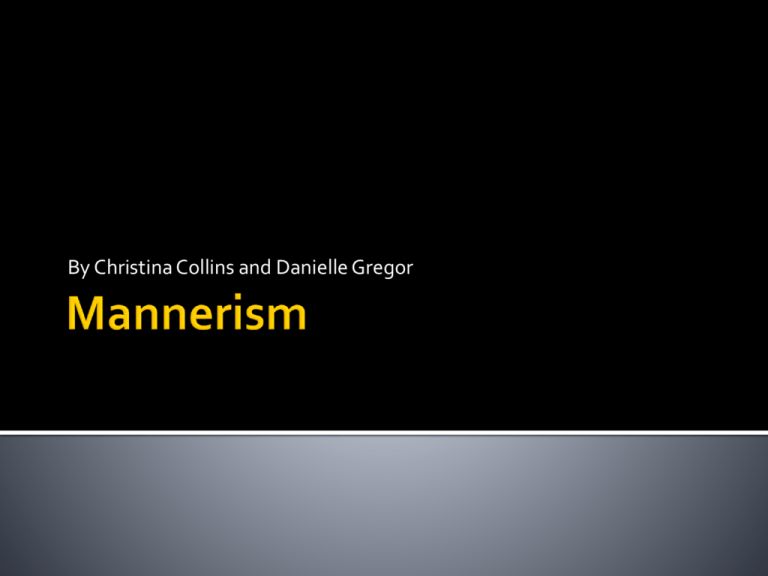
By Christina Collins and Danielle Gregor
This artistic era started in the 1520s and ended in
the 1600s
It was a style of art that permitted artists to
express their feelings; freedom of artistic
expression; their feelings were portrayed in the
art they create
Aspects of manneristic art are bright colors,
sometimes clashing; very bizarre themes and
tortuous at times
These paintings have an intellectual
sophistication to them
Artificial; unnaturalistic
Elongated limbs and anguished faces
The paintings seemed to favor instability; there
wasn’t balance to the art pieces as opposed to
the paintings of the Renaissance
The artists had their own personal take on the
art they made; their own style
Popular artists who painted manneristic pictures
were Da Vinci, Rafael, Michelangelo;
Michelangelo was the main role model for the
painters of manneristic art
The Mannerism era came through towards the
end of the High Renaissance and was less
popular as Baroque style rose in popularity,
becoming it’s successor towards the end of the
1600s
The music of this era was highly floored and just
as sophisticated as the art.
Painted by Parmigianino
from 1534-1535 and was
not completed before he
died
As put in the name of
this art piece, Madonna
was painted with a long
neck.
This portrays mannerism
by the elongated neck
on the woman in the
center, as well as the
baby’s body
Mannerism emerged around the time of the
Reformation and the Counter Reformation.
There was much political and social discontent
with the church at this time.
The painting seemed to be centered on
distortion, vivid colors, tension, and unreal
lighting.
It rebelled against the church because the
church wanted the painting to represent bright
colors/lighting; to make it seem more angelic
Not many rebelled against the church so this
painting along with the manneristic style itself
seemed to be a revolution
Painted by Bronzino
from 1540-1546
Many things going on
this picture. Bizarre parts
of it, such as the
Chimera-human thing in
the background.
Tortuous looking man
beneath Venus’s Arm
A strain/tension between
the man and woman at
the top of the painting
Very obscure imagery
This painting was believed to have been a gift to
King Francis I of France.
It is a rather sexual piece, with Venus’s child,
Cupid, getting intimate with his mother. This is
sexualness is believed to be influenced from
King Henry VIII and his multiple wives.
When he went against the church so he could
get another wife, it showed to the public that it
was socially acceptable to admire sexual desires.
The open admiration of sexual desires from
Henry VIII is still prominent in present day
Painted by Michelangelo
from 1511-1512. Painted
on the Sistine Chapel
ceiling.
Distorted limbs, such as
the male genitals on
Adam.
The muscles on Adam is
also enlarged
Light in the background
of the painting clashes
with the darkness
around Adam’s legs and
God’s bubble
In this piece of art, Michelangelo is showing his
respect to the church and biblical themes.
Michelangelo took a different perspective to the
painting of how Adam was created. Many before
him showed God enchanting Adam with a beam
of light.
He depicted the story from Genesis and put his
own touch on it.
Also, his paintings had more elongated limbs on
them so people on the ground could better
make out the paintings on the ceiling
"An Allegory with Venus and Cupid."Bronzino.Web. 11 Jan. 2015.
http://www.nationalgallery.org.uk/paintings/bronzino-an-allegory-with-venus-and-cupid
"Arts."Venus, Cupid, Folly and Time.Web. 11 Jan. 2015.
<http://artsnpaintings.blogspot.com/1975/04/venus-cupid-folly-and-time.html>.
"Bronzino, An Allegory with Venus and Cupid." Khan Academy. 8 May 2014. Web. 11 Jan.
2015. <https://www.khanacademy.org/humanities/renaissancereformation/mannerism1/v/bronzino-an-allegory-with-venus-and-cupid>.
Kagan, Donald. The Western Heritage : Since 1300, AP Edition by Kagan, Ozment, Turner.
Upper Saddle River, N.J.: Pearson/Prentice Hall, 2010. Print.
Katz, Jamie. "The Measure of Genius: Michelangelo's Sistine Chapel at 500." Smithsonian. 9
Apr. 2009. Web. 11 Jan. 2015. <http://www.smithsonianmag.com/arts-culture/themeasure-of-genius-michelangelos-sistine-chapel-at-500-123313873/?no-ist=>.
"Madonna with the Long Neck."Madonna with the Long Neck. 1 Jan. 2015. Web. 11 Jan.
2015.
<http://www.artble.com/artists/parmigianino/paintings/madonna_with_the_long_neck>.
"Michelangelo Gallery."Creation of Adam by Michelangelo, Sistine Chapel Ceiling. 1 Jan. 2015.
Web. 12 Jan. 2015. <http://www.michelangelo-gallery.com/creation-of-adam.aspx>.
"Parmigianino, Madonna of the Long Neck." Khan Academy. 8 May 2014. Web. 11 Jan.
2015. <https://www.khanacademy.org/humanities/renaissancereformation/mannerism1/v/parmigianino-madonna-of-the-long-neck-1530-33>.
Teixeira, Nuno. "Pop Culture Art Inspired By Michelangelo's." Bit Rebels RSS. 3 June 2012.
Web. 11 Jan. 2015. <http://www.bitrebels.com/geek/pop-culture-art-inspired-bymichelangelos-the-creation-of-adam/>.
Williamson, Michael. "Instantaneous Art Through the Ages"


